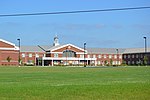St. Marys, Ohio
1834 establishments in OhioCities in Auglaize County, OhioCities in OhioPopulated places established in 1834Use mdy dates from December 2018

St. Marys is a city in Auglaize County, Ohio, United States. Located in western Ohio, it is 11 miles (18 km) west of Wapakoneta and 20 miles (32 km) east of the Ohio–Indiana border. Founded in 1823, the city is located on a portage between the St. Marys and Auglaize river systems, which was a significant factor in its development before the era of canals. The population was 8,397 at the 2020 census. It is included in the Wapakoneta micropolitan area.
Excerpt from the Wikipedia article St. Marys, Ohio (License: CC BY-SA 3.0, Authors, Images).St. Marys, Ohio
West High Street,
Geographical coordinates (GPS) Address Nearby Places Show on map
Geographical coordinates (GPS)
| Latitude | Longitude |
|---|---|
| N 40.544166666667 ° | E -84.39 ° |
Address
West High Street 110
45885
Ohio, United States
Open on Google Maps








